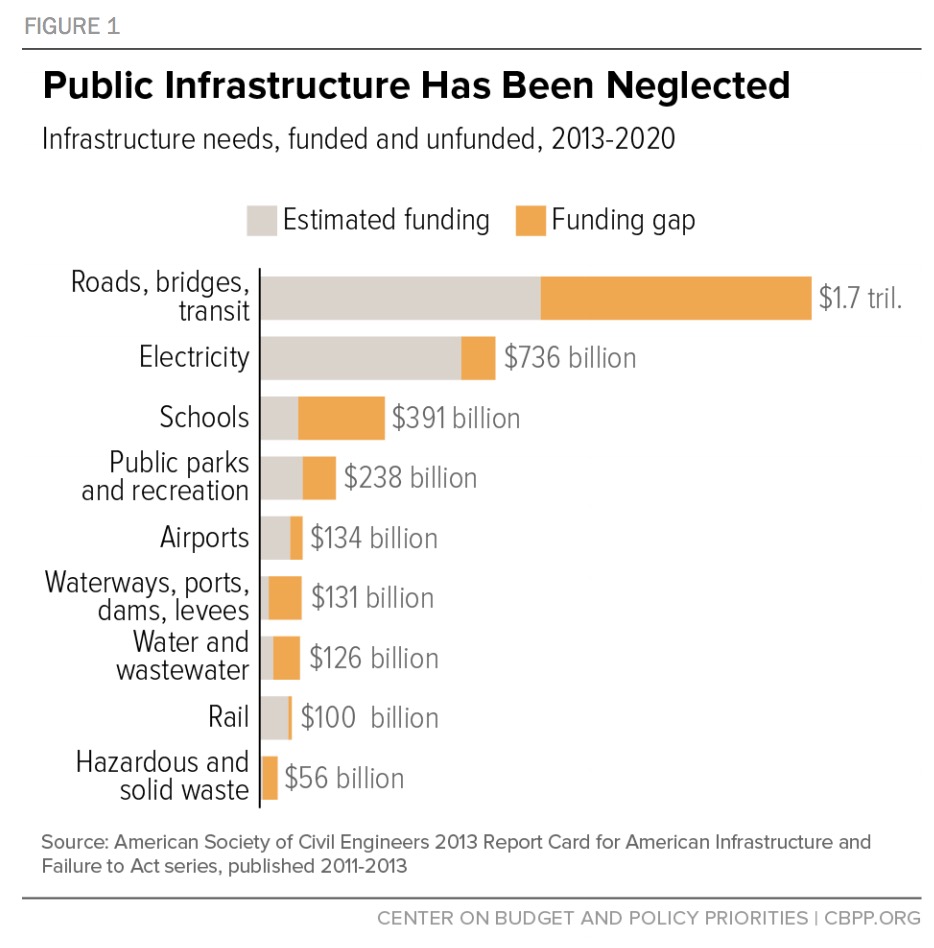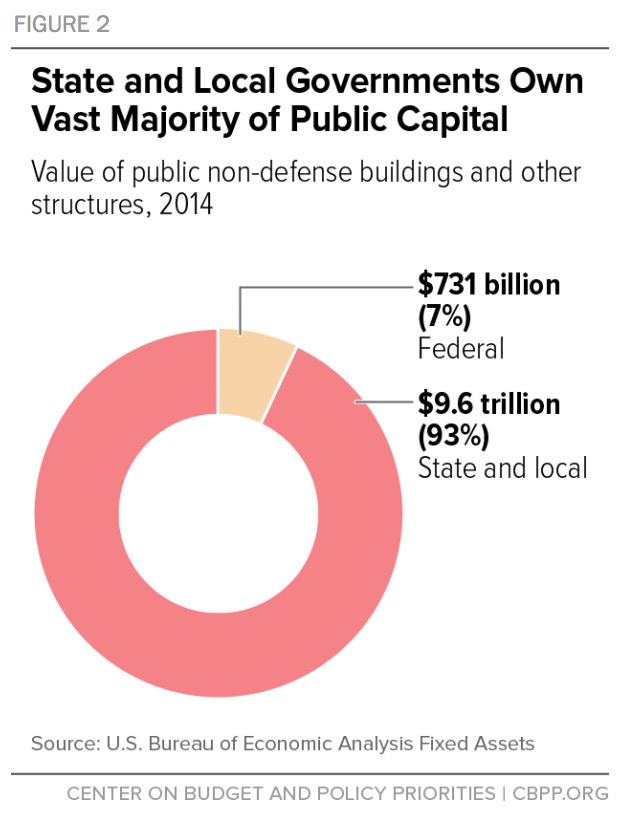CENTER ON BUDGET AND POLICY PRIORITIES
By Elizabeth C. McNichol
Reversing the decline in state investment in transportation, public buildings, water treatment systems, and other forms of vital infrastructure is key to creating good jobs and promoting full economic recovery — and this is an especially good time for states to do it.
The condition of roads, bridges, schools, water treatment plants, and other physical assets greatly influences the economy’s ability to function and grow. Commerce requires well-maintained roads, railroads, airports, and ports so that manufacturers can obtain raw materials and parts, and deliver finished products to consumers. Growing communities rely on well-functioning water and sewer systems. State-of-the art schools free from crowding and safety hazards improve educational opportunities for future workers. Every state needs infrastructure improvements that have potential to pay off economically in private sector investment and job growth.
But rather than identifying and making the infrastructure investments that provide the foundation for a strong economy, many states are cutting taxes and offering corporate subsidies in a misguided approach to boosting economic growth. Tax cuts will spur little to no economic growth and take money away from schools, universities, and other public investments essential to producing the talented workforce that businesses need. This pattern of neglect of infrastructure by states — the primary stewards (along with their local government partners) of the nation’s infrastructure — has serious consequences for the nation’s growth and quality of life as roads crumble, school buildings become obsolete, and outdated facilities jeopardize public health.
States should address unmet infrastructure needs now for several reasons:
- The investment will improve state economies, now and in the future. Higher-quality and more efficient infrastructure will boost productivity in states that make the needed investments, lifting long-term economic growth and wages. In the short term, even though employment is recovering, millions of Americans are working less than they would like and making less than it takes to get by. Key infrastructure investments would provide immediate job opportunities.
- Opportunities to finance infrastructure investment abound. States often pay for building new schools, roads, airports, water treatment facilities, and the like using debt, a sound practice for financing infrastructure that can serve generations. Today’s historically low interest rates are especially favorable to such borrowing, and state and local debt is below pre-recession levels. States also have many other revenue sources available including user fees like tolls as well as federal grants.
- States are in a better position to afford these investments than they’ve been in several years. The nation’s economy has slowly recovered from the Great Recession, finally lifting state revenues above pre-recession levels, better enabling states on average to afford infrastructure investments. But in many states, revenues aren’t sufficient to adequately cover the costs of needed services such as education and health care, and still make the necessary infrastructure investments. These states will need to consider tax increases to preserve public capital that is crucial to long-term economic growth while meeting other needs.
A number of states have recognized the historic opportunity and need for infrastructure investments. For example, Connecticut and Washington are in the early stages of multi-year transportation improvement initiatives. Last year, in more than ten states, including Idaho and Georgia, gas tax increases funded road construction.
But overall, states are cutting infrastructure spending as a share of the economy, the opposite of what is needed. Spending by state and local governments on all types of capital dropped from its high of 3 percent of the nation’s Gross Domestic Product (GDP) in the late 1960s to less than 2 percent in 2014. Falling federal spending on infrastructure is exacerbating the problem.
States must turn their attention back to the type of infrastructure investments that will boost productivity, support business growth, create jobs, provide a healthier environment, and improve opportunities for all of their residents. The specific investments needed will differ from state to state depending on factors like the condition of the existing infrastructure and the mix of industries in the region, but states continue to ignore needed investments at the country’s peril.
Investment in Public Infrastructure Is Falling, With Real Consequences
In the decades after World War II, the United States built an interstate highway system, hundreds of airports, a massive network of waterworks, expanded port facilities, and other infrastructure that significantly boosted the country’s economic output. Much of this infrastructure is in dire need of repair. In addition, better functioning infrastructure, including more efficient public transit systems and more environmentally friendly water and sewer systems, could boost economic growth and quality of life. Despite these needs, governments at all levels are failing to make the improvements that the nation’s roads, bridges, and other infrastructure need.
 The Nation’s Infrastructure Needs Improvement
The Nation’s Infrastructure Needs Improvement
Across the United States, years of neglect have resulted in crumbling roads, bridges in need of repair, inadequate public transport, outdated school buildings, and other critical infrastructure needs.
In its most recent report card on the condition of America’s infrastructure, the American Society of Civil Engineers (ASCE) gave U.S. infrastructure a D+ or “poor” rating. The engineers estimated the cost of bringing America’s infrastructure to a state of good repair (a grade of B) by 2020 at $3.6 trillion, of which only about 55 percent has been committed. Improving roads and bridges alone would require almost $850 billion more than states, localities, and the federal government have allocated. Schools need another $270 billion beyond what’s been invested. (See Figure 1 and Table 2 in the Appendix.)
 Other studies have supported and built on the ASCE findings. For instance, America’s drinking water treatment and distribution systems need $384 billion in investments over the next 20 years, according to the Environmental Protection Agency. Over half of America’s public schools need to be repaired, renovated, or modernized according to a U.S. Department of Education survey. And almost 20 percent of the country’s roads are in poor condition, according to the Federal Highway Administration’s most recent survey.
Other studies have supported and built on the ASCE findings. For instance, America’s drinking water treatment and distribution systems need $384 billion in investments over the next 20 years, according to the Environmental Protection Agency. Over half of America’s public schools need to be repaired, renovated, or modernized according to a U.S. Department of Education survey. And almost 20 percent of the country’s roads are in poor condition, according to the Federal Highway Administration’s most recent survey.
These needs vary significantly by state because of differences in size, congestion, and age of existing infrastructure. For example, 41 percent of the roads in Rhode Island are in poor condition, while only 11 percent of roads in North Carolina are, according to ASCE. Illinois needs $19 billion to improve its drinking water treatment facilities while Georgia — with a population similar to Illinois — needs about half that. The ASCE report card also includes information on state infrastructure needs and investment.
Download full version (PDF): It’s Time For States to Invest in Infrastructure
About the Center on Budget and Policy Priorities
www.cbpp.org
“We are a nonpartisan research and policy institute. We pursue federal and state policies designed both to reduce poverty and inequality and to restore fiscal responsibility in equitable and effective ways. We apply our deep expertise in budget and tax issues and in programs and policies that help low-income people, in order to help inform debates and achieve better policy outcomes.”
Tags: Center on Budget and Policy Priorities, Elizabeth C. McNichol, States






 RSS Feed
RSS Feed